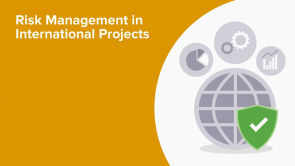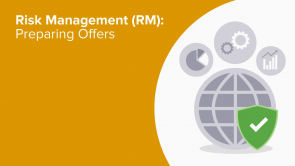Risk Identification I

Über den Vortrag
Der Vortrag „Risk Identification I“ von Simone Hoferer ist Bestandteil des Kurses „Risk Management (RM): Preparing Offers“. Der Vortrag ist dabei in folgende Kapitel unterteilt:
- Identification of opportunities
- Crucial question
- Collecting data & lateral thinking
- a) Check the project request data
- b) Similar projects & lessons learned
- c) Research
- d) Interview experts
Quiz zum Vortrag
The identification of opportunities and risks is ...
- one of the most important steps in the risk management process.
- not really relevant. It is much more important to put action measures into effect.
- easy to conduct and it just needs to be done to meet the requirements.
- time consuming and only to be conducted by the project manager.
The purpose of identification of chances and risks is ...
- to make potential dangers and opportunities visible.
- to recognize and specify potential causes for dangers and changes and to prepare them for further action steps.
- to discuss project problems and to exchange personal experience.
- to meet the requirements of controlling.
Why is the identification of risks and chances so important especially in the quoting stage?
- Because only the identified and known risks and chances can be incorporated into or considered for the quote.
- Because only known risks can be converted into opportunities and only known chances can be exploited.
- Because a good identification can be compared with a good travel planning. When I know what to expect up ahead, I can prepare myself.
- Because identification will expose every future problem and due to that one can exactly predict future events.
What are the main identification criteria?
- Big, new, indistinct, complex and extra
- Big, new, indistinct, complex and intra
- Big, old, indistinct, complex and extra
- Big, new, indistinct, simple and extra
What do you need to consider when you plan to extract knowledge from previous similar projects or lessons learned?
- Do not trust old data.
- Be aware of the danger of being lulled into false security since calamities as well as lucky chances are often one-time events.
- Documentation may be incomplete.
- Collect background information as well as pure data.
- Situations are usually comparable.
When doing research...
- search specific and systematic.
- intensely engage into the subject.
- search the internet, libraries, in archives, agencies, etc.
- go for a broad research first.
When doing research...
- search specific and systematic.
- intensely engage into the subject.
- search the internet, libraries, in archives, agencies, etc.
- go for a broad research first.
What are possible negative aspects when conducting expert interviews?
- High expenditure of time for preparation, wrap-up and evaluation
- Danger of highly personal tinged opinion
- Sound and fast assessment of the actual situation
- Structured query of knowledge and experience
Kundenrezensionen
5,0 von 5 Sternen
| 5 Sterne |
|
5 |
| 4 Sterne |
|
0 |
| 3 Sterne |
|
0 |
| 2 Sterne |
|
0 |
| 1 Stern |
|
0 |
Auszüge aus dem Begleitmaterial
... Risk Management Process 6. Communication 1. RM-Design ...
... well-established methods for risk identification and their field of application > To gain knowledge on how to phrase risks as ...
... >>> Is the most important step ...
... which have been identified as such. Only known risks can be converted to chances. Competitive advantage and project ...
... 77 Indicators for potential dangers ...
... Because the not identified perils cause the biggest problems and consume scarce resources ...
... we have to look out for risks and chances. But how to look out ...
... Would you research, ask experts, read books, rummage the internet and check for travel reports? Would you investigate the entry regulations, the ...
... I do if it were my adventure vacation?“ May be a very helpful question during ...
... your team an lateral thinking. For this stage the amount of collected points is most important. After that you ...
... and lateral thinking: a) Check the project request data b) Check similar projects and ...
... as your first impression. Move from overall view more and more into details. Move from familiar to unfamiliar ...
... Duration? Where? Is the request complete and evident? What is the estimated volume of sales compared to company turnover? ...
... dimension, distance, quantity = single position, total volume in proportion. Extra: non-standard, extraordinary = more effort regarding costs, ...
... item (product, service, technology), Time (timeframe, deadline, shipping), Country (destination and transit countries), Constellation ...
... compare it to the real outcome after completion. After a while of training your intuition will increase. For experts intuition is most of ...
... and note in a very short time everything you notice and what draws your attention. Make a estimation of the sales volume and the outcome of the project and its possible problems. Compare your assessment ...
... of project. Filed in a written, structured and accessible form. > Also systematic processed know-how ...
... ask colleagues, sales, seniors & department heads, check your own projects, collect data. Check inside and outside of your ...
... can participate in the experience of others and apply and use it for your own project ...
... up to date - Danger of being lulled in to false security or trapped into false anxiety since calamities as well ...
... understand the context and the real events and how information can be applied to actual project. Check transferability of data ...
... Intensely engage into the subject. Get to know the background, connection and correlation ...
... to start researching. Check reliability and actuality of gathered data. Collected information needs to be evaluated. Cross check ...
... e.g. highly experienced senior colleagues. In written form or in a personal conversation. Questions regarding: personal opinion, ...
... can immediately be given if necessary in personal conversation - Structured query of knowledge and experience - Sound and fast ...
... Brainwriting - Creative association games. Visualizing - Project flow chart ...
... a creative „warm-up“ at the start. Provide secure and trustful environment. Explain the rules and ensure rules to be observed ...
... Seizing up and combining previous. Create creative atmosphere, welcome bold ideas. Everybody to express ideas ...
... e.g. via chat or shared documents (which should be worked on by several participants at the ...
... the point of view of the project after completion. What would the project like to address? How was the preparation? How was the ...
... does it require during shipping, leaving home country and entering the destination country? What is absolutely necessary and what is ...
... chances using graphs, charts, travel routes and pictures. Using different regions of the brain: different associations, thoughts ...
... and interdependence of individual stages. 111 e) Visualization of project flow chart planning production shipping installation hand- ...
... complexity, interest and dependences obvious. 112 e) Visualizing project structure plan Graphic10: ...
... To identify conflicts, bottlenecks, dependencies, connections and potential conflicts. ...
... route on a map you may identify following issues: Required means ...
... of the RM-planning. Capture the key issues and check for completeness. Systematic questionnaire to identify weak points, bottlenecks ...
... much effort to will I put into which project? Tip: use the most effective and reliable ...
... summary: a) Check the project request data b) Check similar projects & use lessons learned c) ...
... fishing net: it should be close meshed enough to safe your project from sharks. ...
... To use your experience as a start is a good thing to do. However it´s more important especially for ...
... We familiarized us with the project. ...
... What is the next logical step? ...
... is there a realistic chance to happen? (check context) ...
... satisfaction - market position - product portfolio - processes/ structure - facility - qualification/ team - resources ...
... can be analysed, evaluated and actions steps to be found. > Easy to comprehend ...
... of risks: „cause- risk - effect“ format by Roland ...
... unpredictability of an outcome as danger or opportunity. Effect: draw up the likely consequences for the ...
... effect, cause: various native languages, communication in third language (English), risk/chance: ...
... market position, Tight time schedule, Unforeseen events cannot be compensated, less competitors, Delay and additional costs, assignment due to specialization ...
... become aware of the chain of cause and effect. Dangers are not appearing out of nowhere. Provides beneficial ...
... risks > The more precise you work in this stage the easier and faster it will be ...
... Identification of risks and opportunities consists of three steps ...
... 2. Identification 3. Assessment & Evaluation ...




